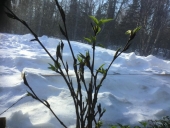Starlie Scarborough wrote:Yes, the cottonwood is for shading purposes and habitat. No lumbering involved. They are chosen because they grow well next to a river.
From what I can tell you are looking for information on the ecology and simbiotic relationships within a cottonwood forest in a river drainage region?
Cottonwoods do grow well beside water, as do it's close relatives the various poplars.
Another great tree capable of growing in and around water being the willows. I have willows all around my ponds for shade. At my last foster home we had cottonwoods around our 15 acre pond.
My brother in law rented some pasture for the last few years and it has a swampy drainage area and it is full of poplar and willow growing out of the standing water. I thinned it all out for him a few years back and then milled it all into lumber.
The thing that grows the best in those environments around the trees are sedges and other water tolerant plants. The sedges will be worldwide, but the type of water tolerant plants beyond that will change by climate and region.
As for non plant ecological footprint, there tend to be a lot of birds, amphibians, mosquitoes etc..
These areas tend to have a very high organic content in the soil, the water movement tends to remove clays over time and silt in with organic materials. This makes for a very organic rich soil that hold water well.
While I have been around environments like this all of my life, I have never really studied any of it, all I can give is some basics that I know for fact. Honestly my attention was most always on not getting stuck and cutting trees... Personally I love cottonwoods and have been trying to get some cottonwoods and poplars growing in the marshy area of my hay field by my ponds here on this farm. My problem is that my goats tend to eat the bark on the trees faster than I can plant them. I got rid of all of my goats two years ago though one escaped and stuck around and he is still eating all the trees that I plant here. I planted another 20 poplars last fall and there is again no bark on them whatsoever. I will be trying to shoot him again soon in defense of my trees and garden.
I don't doubt I can remember more with a bit of time, but that is about it at the moment, my thought patterns are not designed for this mode of thinking so I do not have most of what I have observed in memory when it comes to what you seem to be looking for. Maybe something in here gives enough insight to get you headed in the right direction. It is common out here on farms to have drainage and wet areas that are tough or impossible to farm and the government supports something called "riparian" zones in such regions of farms. You may be able to find some information that is useful to you by studying "riparian" zones.






